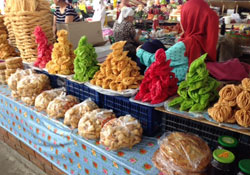FEEDCities project – studying urban food environments

WHO
FEEDCities is an ongoing multicountry study, which describes the urban food environments of cities in central Asia, the Caucasus and south-eastern Europe. These cities (and countries) have street markets and other vending sites that play a unique and important part of their food culture. These vending sites offer a diverse range of nourishing fruits, vegetables, nuts and whole grains.
However, unhealthy diets are becoming an increasingly urgent risk factor for noncommunicable diseases, and foods possibly high in trans-fatty acids and sodium (salt) are becoming more prevalent. Strong evidence links trans-fatty acids intake to coronary heart disease, whereas excessive sodium intake can significantly increase blood pressure, which is a major driver of stroke and other cardiovascular diseases.
The study aims to describe the vending sites (including food markets, kiosks and street vendors) selling ready-to-eat food in urban areas and to document the types of food most commonly available. It also assesses the trans-fatty acids and sodium content of these foods – both homemade and industrially processed – based on laboratory analyses of locally-obtained food samples. It aims to fill a gap as little information is currently available on the nutritional composition of ready-to-eat foods from markets and other vending sites in the eastern part of the WHO/Europe Region.
The study is coordinated by WHO/Europe and the University of Porto, and is financed through a voluntary contribution of the Ministry of Health of the Russian Federation.
Aims of the field work
Field work is now completed in 3 countries: Kyrgyzstan, the Republic of Moldova and Tajikistan. It was carried out with the support of the ministries of health and WHO offices in each country,
Tajikistan was the first country to launch the data collection phase, with a team of field workers receiving training from WHO/Europe and project partners from the University of Porto, Portugal. A total of 10 markets were canvassed, with 1073 vending sites interviewed. A total of 100 homemade and 40 industrially processed food samples were collected, corresponding to the most commonly available foods previously identified. The same methodology was pursued in Kyrgyzstan, with homemade and industrially processed food samples collected from the 10 market sites canvassed.
In the Republic of Moldova, the study area focused on the Central Market in Chisinau and a 1 km buffer around it. All eligible vending sites within this buffer were canvassed. Small markets (or corner shops) were also included, as they are particularly common in the country.
Initial findings
Preliminary results show that in countries from the central Asian region commonly available homemade foods include many different types of bread (e.g. lavash; lepyoshka), savoury pastries (e.g. piroshky; chebureki), and soups. Traditional foods typical to the region are also widely available, such a manty in Kyrgyzstan (meat or vegetable dumplings) and samsi in Tajikistan (baked meat pies, cooked in a tandoor). Industrially processed foods are also commonly available, including cookies, cakes and potato chips.
Industrially processed foods, including chocolate, sweet baked goods, and crackers, were the most commonly available foods in Chisinau. However, preliminary results also indicate that homemade foods such as sweet pastries (e.g. plăcintă) and kebabs (shwarma) are also common.
Next steps
WHO/Europe will continue to implement this study in at least 4 other countries in the WHO European Region during 2016 and early 2017. As the results of the laboratory analyses become available, WHO will work with countries to interpret the findings and develop an appropriate response.



